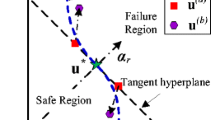Abstract
In this paper, response surface method has been implemented for modeling a mechanical spring-mass system. Simulated experiments based results are used for developing a design matrix. The design matrix is then used in conjunction with central composite design method so as to develop the response surface for first natural frequency using regression analysis. Analysis of variance is also performed in order to check for statistic significance of response surface model. Results show that response surface model produced during this work is statistically significant and hence can be used for further model updating related research work.
Access this chapter
Tax calculation will be finalised at checkout
Purchases are for personal use only
Similar content being viewed by others
References
Cochran G, Cox GM (1962) Experimental design. Asia Publishing House, New Delhi
Den Hartog JP (1934) Mechanical vibrations. McGraw-Hill Book Company Inc, US
Design-Expert (2010) User’s guide for version 8 of design-expert. Minneapolis, MN: Stat-Ease Incorporation
Ewins DJ (2000) Modal testing: theory, practice and application. Research Studies Press Limited, England
Friswell MI, Mottershead JE (1995) Finite element model updating in structural dynamics. Kluwer Academic Publishers, The Netherlands
Kansal HK, Singh S, Kumar P (2005) Parametric optimization of powder mixed electrical discharge machining by response surface methodology. J Mater Process Technol 169:427–436
Matlab (2004) User’s guide of matlab v7. The Mathworks Incorporation, New York
Montgomery DC (2004) Design and analysis of experiments. Wiley, Singapore
Petyt M (1998) Introduction to finite element vibration analysis. Cambridge University Press, Cambridge
Sehgal S, Kumar H (2012a) Structural dynamic analysis of cantilever beam structure. Int J Res Eng Appl Sci 2(2):1110–1114
Sehgal S, Kumar H (2012b) Modal testing of a cantilever beam structure. J Eng Technol Educ 6(1):25–29
Silva NMM, Maia JMM (1997) Theoretical and experimental modal analysis. Research Studies Press Limited, England
Acknowledgments
This work was supported by the university grants commission, New Delhi, India under major research project grant sanctioned via f-42-869/2013(SR).
Author information
Authors and Affiliations
Corresponding author
Editor information
Editors and Affiliations
Rights and permissions
Copyright information
© 2014 Springer India
About this paper
Cite this paper
Sehgal, S., Kumar, H. (2014). Response Surface-Based Modeling of Mechanical System. In: Khangura, S., Singh, P., Singh, H., Brar, G. (eds) Proceedings of the International Conference on Research and Innovations in Mechanical Engineering. Lecture Notes in Mechanical Engineering. Springer, New Delhi. https://doi.org/10.1007/978-81-322-1859-3_7
Download citation
DOI: https://doi.org/10.1007/978-81-322-1859-3_7
Published:
Publisher Name: Springer, New Delhi
Print ISBN: 978-81-322-1858-6
Online ISBN: 978-81-322-1859-3
eBook Packages: EngineeringEngineering (R0)




